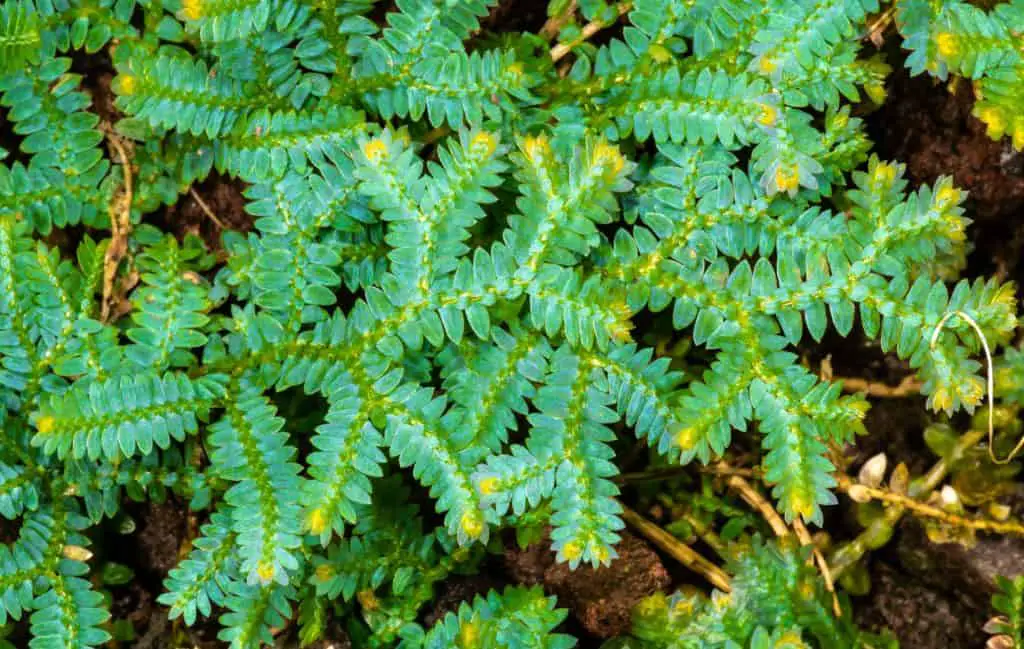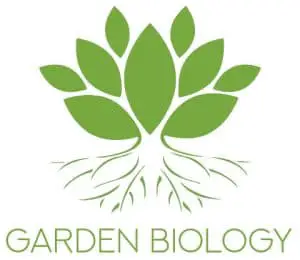A Peacock fern is surprisingly not a fern. Some of its other common names include peacock moss, rainbow moss, spike moss, and more. However, it is not a moss either. The peacock fern belongs to a group of plants called Lycophyte. Lycophytes are vascular plants and they are one of the oldest living groups of plants.
Why are Peacock ferns called ferns and moss? Like many plants, they have several common names because people have described them based on their looks and attributes. The Selaginella uncinata (the peacock ferns scientific name) has foliage that resembles a fern but it grows similar to moss.
The Selaginella uncinata is a beautiful plant that has an iridescent almost metallic blue-green color. This plant looks like different colors in different lighting and angles due to its iridescent nature. At one angle the plant may appear purple while at another angle it looks blue.
The show-stopping plant is native to southern China and can be found in homes and terrariums across the United States. This ultimate care guide will give some insight on how to care for a peacock fern and some common problems the plant faces.
Peacock Fern Care
Peacock ferns do not require a ton of care, but some things should be known about how to care for them. They can be finicky about lighting, water, and humidity. This section of the article will discuss how to care for a Selaginella uncinata plant.
The peacock fern is a fairly easy plant to care for. They can be planted inside a house, in a terrarium, in a garden, or near an aquarium. This versatility makes them an excellent option for someone looking to get into plants. They do require shade and a humid, moist environment.
How to care for Peacock Fern indoors?
A peacock fern can be an excellent indoor plant since they like low light. They do best in hanging baskets as they grow over the sides of planters. They can also thrive inside terrariums and outside of aquariums.

Lighting Requirement
Peacock ferns love high amounts of indirect light. Their blue iridescent coloring thrives in lower light conditions. Low light does not mean no light source. Lighting may need to be supplemented if there is not enough natural light coming in for the plant.
These plants should ideally be planted in full shade areas or areas that only receive morning light. Constant direct light can scorch a peacock fern’s leaves.
Soil Type & pH
The peacock fern prefers soil that retains water well and it likes a pH of 6.1-6.6. The fern has short roots which is why it prefers soil that has high water retention. Generally, the pH of the soil only needs to be tested every 3-5 years for established plants.
Watering Requirement
Even though the peacock fern is not a true fern, it does thrive in a very moist environment like many other ferns. This plant thrives with routine consistent watering. It is recommended to check the soil every 2-3 days and only let the top inch of the soil dry.
Humidity, Temperature, and Hardiness Zone
Peacock ferns are considered a tropical plant and therefore love temperatures in the 80s with a humidity of at least 90%. They will thrive as long as the temperature does not drop below 50 and the humidity is around 50%. Hardiness zones 6-10 are where this plant thrives.
Fertilization Requirement
Selaginella unciata requires little food and fertilizer. It performs best with a water fertilizer that is applied once during the spring. Many gardeners recommend diluting the fertilizer with water to ½ the strength and fertilizing again in the summer.
A newly potted peacock fern should not be fertilized for at least the first two months. If a fish emulsion is used as the fertilizer, follow the instructions on the container. Just be mindful to not over-fertilize the plant as over-fertilization can scorch the plants’ leaves.
Propagation
Stem cuttings and divisions are both great ways to propagate this plant. If the piece of the stem has roots forming it can be transplanted into soil any time of the year. Dividing the plant is best done during the spring months.
Size & Growth Rate
Selaginella Uncinata will typically grow a couple of inches tall, but it will grow very wide. At a maximum, they grow to 10 inches tall. However, they more commonly grow to 6 inches tall and can spread up to 20 inches wide. Selaginella uncinata is considered a slow-growing plant.
This plant can begin to grow over the sides of a planter within a couple of weeks. Regular trimmings will help keep it in check and prevent it from overtaking your pot or basket. Pinching back the tips of the stems is a form of pruning that will stimulate the plant to start growing wider instead of upwards.
Problems Growing Peacock Fern
No matter if this is a person’s first plant or their 100th, everyone runs the risk of accidentally killing their plants. The peacock ferns are prone to drying out and over-fertilization. Spider mites and mealybugs are also known to infest these plants and can cause severe damage.
Why are the leaves turning yellow?
Three main things can be causing your peacock fern to turn yellow. These plants thrive in moist soil, and their leaves can turn yellow when they are not receiving enough water. They are also easily scorched by the sun and they can be scorched by over-fertilization.
Fertilizer that is applied too often can burn the peacock fern. During the spring when temperatures start to rise the plant can be fertilized with a water-soluble fertilizer. A second application can be applied mid-way through summer. House plants should not be fertilized during the winter months as this is a rest period for them.
Can I Save my Peacock Fern?
If the peacock fern has dead leaves and stems, it is recommended to remove them. The plant will continue to send vital nutrients to the dead parts in an attempt to salvage itself. However, this can kill the plant because it is focusing so much on the dead parts that the living stems begin to become neglected.
Ensure that no more than the top inch of the plants’ soil is drying out, and maintain a consistent watering routine. Some people have had success with bringing their plant back to life by placing a sheer curtain around the plant to keep the sunlight from scorching its leaves and causing more damage.
Mealybugs
Mealybugs are one of the most common pests on Selaginella Uncinata plants. These bugs can look like pieces of cotton on a plant. They can cause the plants’ leaves to turn yellow, slow down growth, weaken stems, and more.
These pests should be taken care of as soon as they are noticed. A female mealybug can lay 500 eggs in as little as two weeks. The immature bugs can easily be trapped with sticky traps placed around the plant.
Spider Mites
Spider mites can be very difficult to detect as they are 1 mm in length. They often look like tiny red dots on the leaves and stems of plants and they can give the leaf a gritty feeling. They can make leaves discolored and splotchy in appearance. A severe infestation can stunt the plants’ growth and kill the plant.
Are Peacock Ferns toxic to cats?
Thankfully, peacock ferns are not toxic to cats. Most people will recommend placing the plant where a cat or dog cannot eat it. While it is safe if ingested, it is still best to avoid letting a cat become used to eating plants.
Where can I find Peacock Fern for sale?
Peacock ferns can be found at a local home improvement store. They are also available in some online plant shops. Their prices range from $12-40 depending on the seller, the maturity, and the length of the plant.
Be sure to read a company’s online reviews when purchasing a plant. It is also important to read the fine print of a purchase. Some sellers will show a picture of what the plant will eventually grow into and not what they are going to send. This means the seller may send a young cutting, but the photo shows a mature plant.
In Conclusion
Selaginella uncinata are beautiful plants and will make a great addition to any home or terrarium. They are relatively easy plants to care for as long as they are routinely watered and kept in a shady and humid environment.
They are still prone to pest infestations just like any other plant, but with routine inspections, infestations can be controlled before they become severe. These plants will grow wide instead of tall which makes them amazing for hanging baskets, and as ground cover in gardens.
Hopefully, this article has provided some insight into these amazing plants and how to care for them. Thankfully, the peacock fern can be easily divided and propagated, because once a person falls in love with this plant, they will want more.
